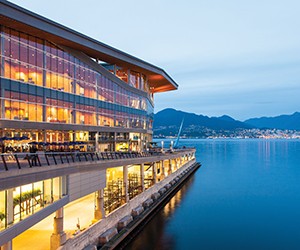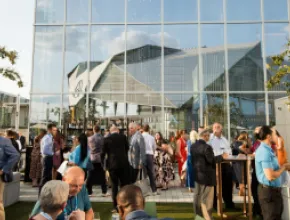As you may have noticed, generic big-box convention centers seem to be going the way of the buggy whip and typewriter.
Trends in meetings education design that are changing the way venues look and function include a variety of learning formats ranging from deep dive sessions to 15- or 20-minute modules, breaks for networking and collaboration, as well as brain refreshment activities like coloring and bead stringing. Adding impetus to the disruption trend are attendees who resist meeting formats that have them all but locked up for several days in the same kind of sterile environment they left at their last meeting location.
The era of gigantic buildings with endless corridors that lead to a sea of same-look meeting rooms are going away.
Changes in motion range from ground-up new building projects to the addition of residential-style furnishings and wall finishes to existing sites. Convention center managers say they are transforming facilities into places where attendees have experiences that are authentic to the destinations. Also, venues are becoming more hospitable to those who want to stay connected with their business and personal lives without leaving convention center premises. Modern convention center spaces have individual attendees in mind, and are becoming more scalable and welcoming.
“A lot of centers are looking at greater flexibility because this is what meeting planners want,” says Amy Ledoux, senior vice president of meetings and expositions for ASAE, sponsor of the annual Springtime Expo. “We are interested in creating areas that accommodate both planned and pop-up learning, and we are working with centers in cities like Nashville and Detroit that help us do this. “
ASAE’s 2015 annual meeting was in Detroit’s Cobo Center, and the group used a newly renovated ballroom that accommodates more flexible meeting space. Divisible spaces and modular furniture help create more meetings flex, Ledoux says, with areas that are more business-oriented. Also, prefunction spaces that are surrounded by views of nature can help refresh attendees and keep them from feeling like they are trapped in a big cement building all day.
Attendees at PCMA’s January Convening Leaders event in the Vancouver Convention Centre also enjoyed a variety of spaces where they could interact, learn and refresh. Claire Smith, vice president for sales and marketing at the center, says the venue’s management staff has been inspired by their work with the influential and popular TED conferences.
“What TED does is revolutionary to what has been the norm for most of the meetings industry, and that is to focus just on keeping people on-site,” Smith says. “TED provides work areas for attendees to conduct full-on business, as well as work stations with privacy where they can carry on a conference call or a meeting with six other people. What we have learned from them is that success is not just about keeping people on-site. A meeting is only as good as the people and dialogue that are part of meetings.”
PCMA’s Learning Lounge by Freeman spanned foyers and prefunction areas of two floors in the VCC West building. Included were engagement spaces where attendees could learn what’s new in tech, tech troubleshooting, social media help stations, gathering places for real work at comfortable tables equipped with power-up stations, and setups with ergonomic chairs for learning with presenters and conversation and networking afterward.
In a recently opened $325 million renovation project of the Henry B. Gonzales Convention Center, San Antonio has new spaces that not only enlarge the center but also make it more welcoming and identifiable with the vibrant city it occupies, says Mike Sawaya, director of San Antonio convention, sports and entertainment facilities.
“We spent a million dollars on our Meeting Room of the Futur, where we have three different types of seating,” Sawaya says. “There are spaces that include a lounge with ottomans, a traditional setup, and one with bar stools and standup tables. The whole space has multicolored felt room dividers so organizers can slice them up a dozen ways.”
The new spaces follow the city’s early efforts to give convention center meeting attendees experiences that are different and more inspiring than what can be found in every other big-box venue.
“About five years ago we did our first space with a residential feel—the Longhorn Dove Room—where furnishings like dark leather and Western art bring a Texas look into the center,” he says. “We hired the screenwriter for Lonesome Dove to design a space with a Texas ranchhouse look and feel, something our customers love. It’s a great place for meetings as well as for time to relax. The fact that it can open out to views of San Antonio’s famed River Walk makes it even more popular.”
People are always looking for spaces that reflect the feel and culture of the city they are in, Sawaya believes.
“Convention centers may be big boxes, but today they need to find ways to be part of the cities they live in,” he explains. “Here in San Antonio, our new look even has prickly pear [cacti] on the exterior of the building.”






